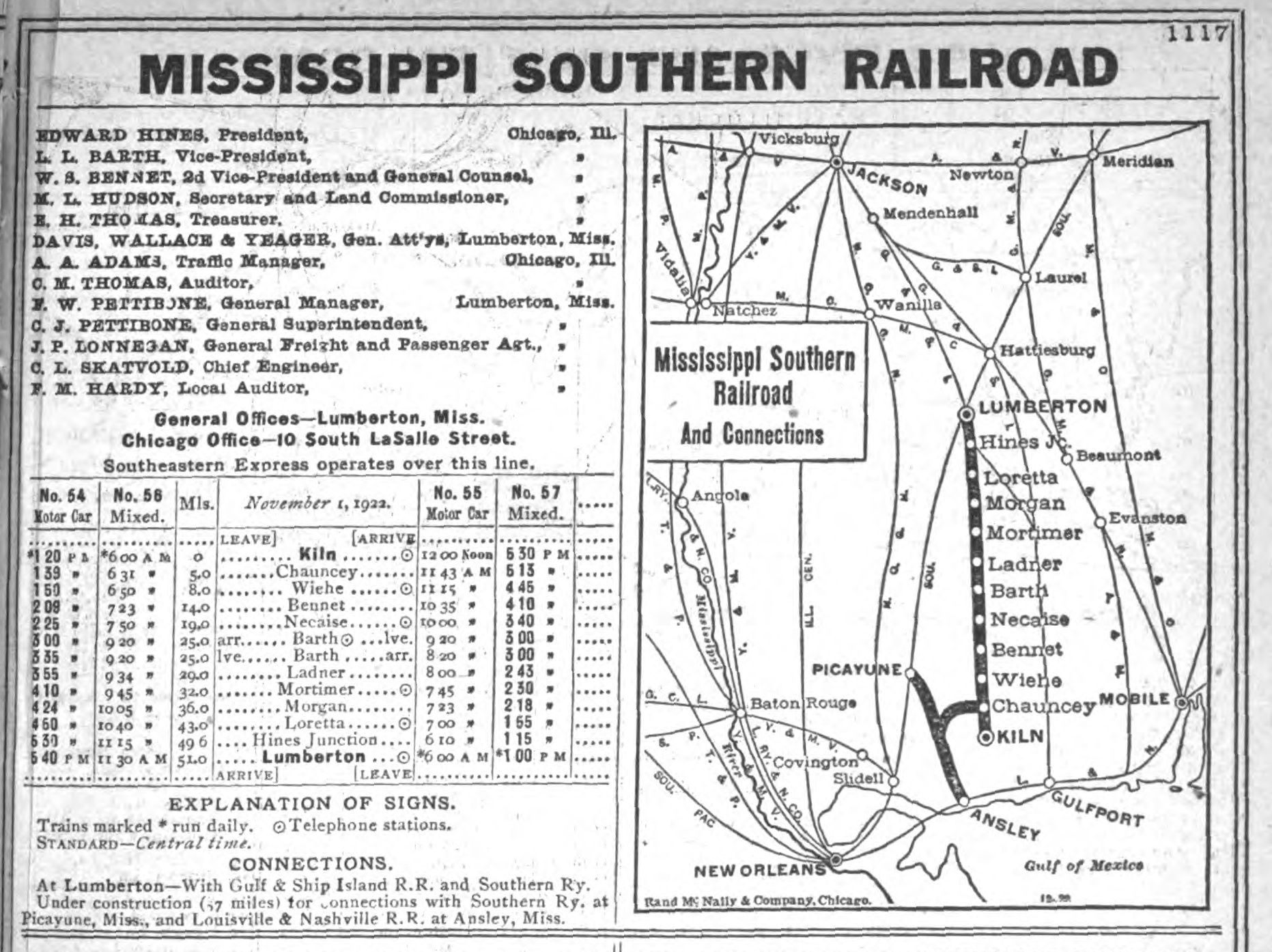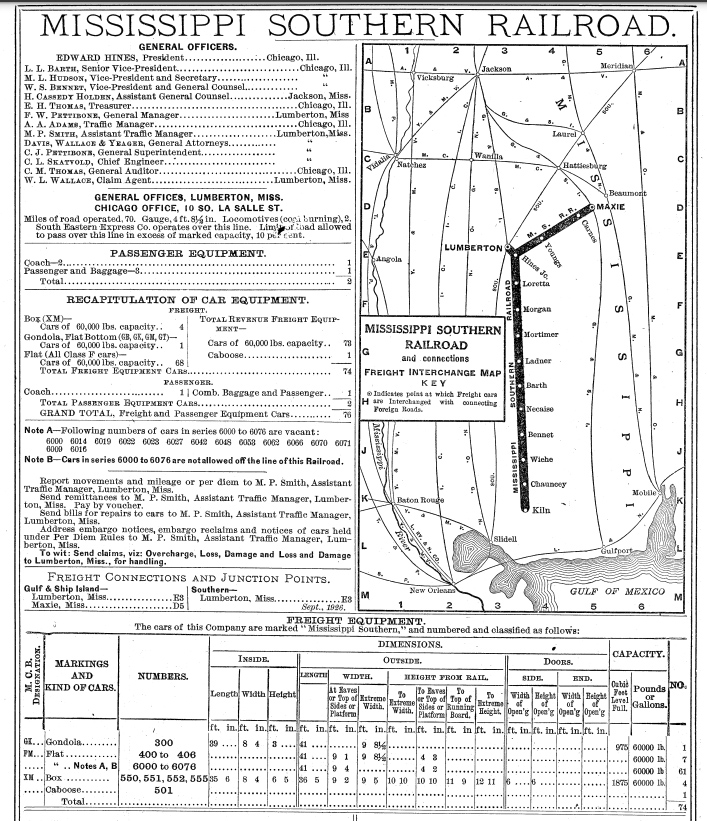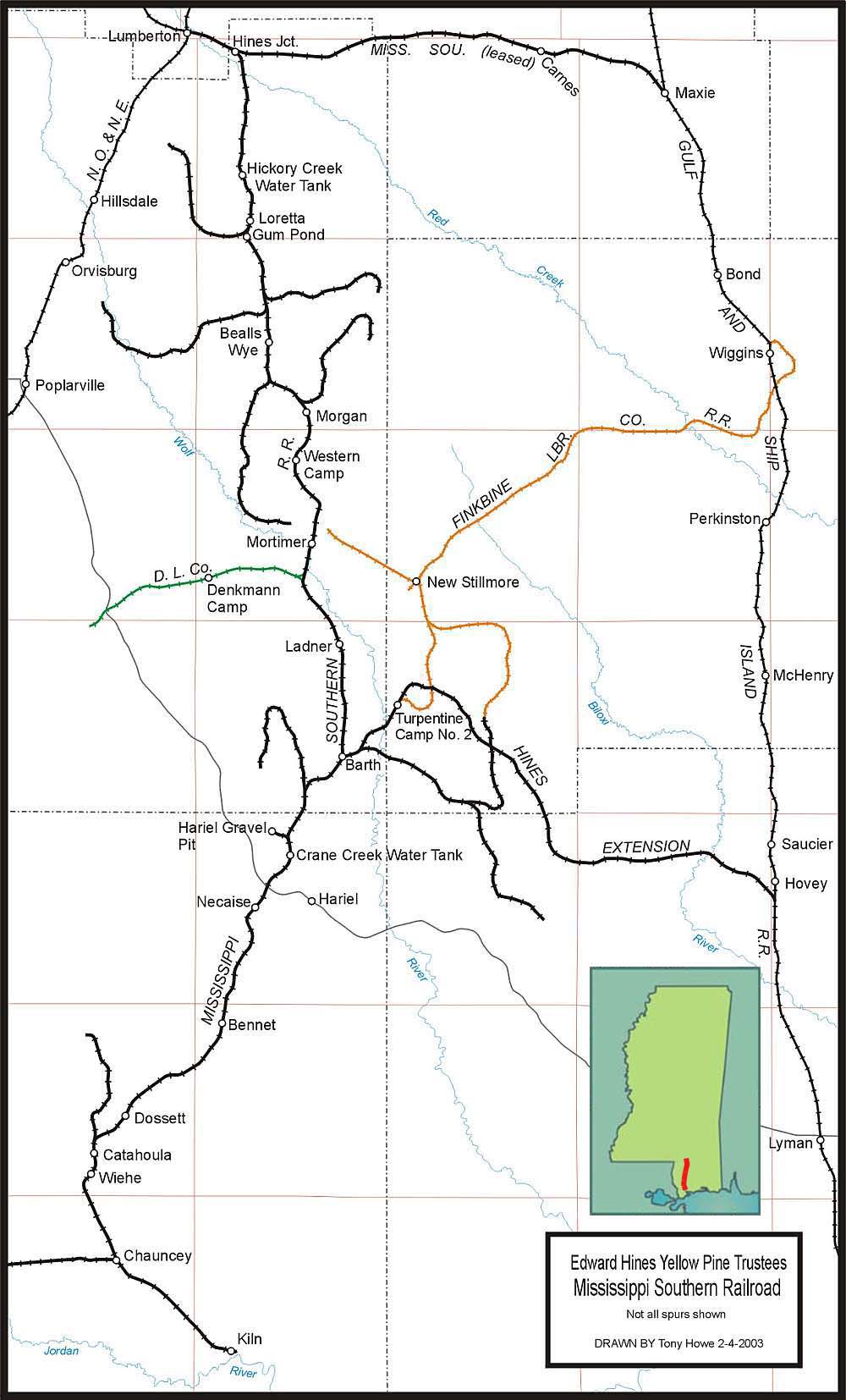
Edward Hines Yellow Pine Co. (1917-1930)
Mississippi Southern Railroad (1922-1930)
|
Standard Gauge Headquarters: Lumberton, MS (Pearl River County) Years of Operation: 1922-1930 Mill Capacity: 100,000 ft/day at Lumberton 300,000 ft/day at Kiln Miles Operated: 49.87 for Mississippi Southern plus many miles of logging spurs owned by lumber company Locomotives Owned: 25 app. |
Equipment:
|
Click Map for Larger Version Google Earth Map HERE |
|
History by Gil Hoffman: The
Edward Hines interests of Chicago bought the sawmill plant of the Hinton
Brothers Lumber Company, at Lumberton, Lamar County, on November 6, 1917.
The purchase also included the entire logging equipment (3 rod
locomotives, 1 scrap locomotive, 2 steam loaders, 1 steam skidder, log
cars, camp cars, etc.). Originally the Hines operation was known as the
"Edward Hines Yellow Pine Company," but the name was changed to
"Edward Hines Yellow Pine Trustees" on January 1, 1918. In 1929
the mill at Lumberton cut out and the company moved to Seneca, Oregon. The
Hines sawmills at Lumberton and Kiln were originally served by two short
logging railroads, one running south from Lumberton and the other running
north from Kiln, for a total of 11 miles. On
June 22, 1916 the Hines people signed a contract with the Gulf & Ship
Island Railroad in which the G&SI agreed to build a railroad from its
main line near Ten Mile, Mississippi, to a connection with the northern
end of the Hines railroad, at Catahoula, Mississippi. The terminus on the
G&SI was later changed to Hovey, Mississippi. The G&SI proceeded
with construction until December 31, 1917, when its railroad was taken
over by the United States Railroad Administration. The USRA then completed
the line for a total length of 24.88 miles. Title to this track was
transferred from the G&SI to the Hines Trustees on June 23, 1921. Afterward
the Hines company built about 25 miles of track to connect their Lumberton
logging road with the line built by the G&SI, at Smith's Wye, thus
completing the line from Lumberton to Kiln, a distance of about 52 miles.
This line included 15.75 miles of railroad built by the G&SI. The
Hines railroad connected with the New Orleans & Northeastern and the
Gulf & Ship Island at Lumberton, and with the logging railroad of the
H. Weston Lumber Company at a point a short distance north of Kiln. The
Weston logging road connected with the NO&NE at Picayune, Mississippi,
and the Louisville & Nashville, at Ansley, Mississippi. The
railroad from Lumberton to Kiln was built primarily to serve the Hines'
lumbering operations. After the line was completed the inhabitants of the
adjacent area wanted it to become a common carrier so that freight could
be hauled for the general public. On
July 6, 1922, the Mississippi Railroad Commission authorized the railroad
from Lumberton to Kiln to be operated as a common carrier in intrastate
commerce, under the name "Edward Hines Yellow Pine Trustees
Railroad." On July 12, 1922, the Hines company applied to the Intestate Commerce Commission for permission to operate its Lumberton to Kiln railroad in interstate commerce. Permission was granted on November 15, 1922. Afterward the railroad was operated under the trade name "Mississippi Southern Railroad" and throughout its existence was not incorporated. On
March 23, 1923 the Hines company filed an application with the ICC for
permission to build an extension of the Mississippi Southern from its
southern terminus at Kiln in a southeasterly direction to a connection with
the L&N at Bay St. Louis, a distance of 9.97 miles. This extension was
desired to obtain a southern connection with a major railroad. Estimated
cost of construction was $246,964. Permission was granted by the ICC on May
23, 1923, with the condition that construction of the extension commence by
January 1, 1924 and completion be reached by December 31, 1924. The
extension was never built. On September 5, 1924 the Hines company applied to
the ICC for permission to lease the line of the G&SI extending from
Lumberton to Maxie, Mississippi, 16 miles. The lease, dated July 15, 1924,
was for a period of 15 years and required the Hines people to maintain the
line, to relay it with new 75-lb. rail and to reballast it. Cost
of rehabilitation was estimated at $220,000. Permission was granted by the
ICC on December 3, 1924. This lease was the reason the southern extension
was never built. On
August 19, 1929 the EHYPT applied to the ICC for permission to abandon the
Mississippi Southern in its entirety as of September 1, 1930. The reason
given was that the parent company's timber was almost exhausted and the
sawmills at Lumberton and Kiln would soon close. Traffic from agriculture
had not developed as expected and what little there was on the line was
moved by trucks. Passenger traffic had dwindled to such an extent that
passenger service was discontinued on April 1, 1929. The line had run in the
red during 1925, 1927 and 1928. Permission was granted on December 20, 1929,
with the provision that the Mississippi Southern provide service until
September 1, 1930.
|
||

July 1923 Official Guide of the Railways |
|
 October 1926 Official Railway Equipment Register- Art Richardson Collection
|
|
|
|
|
|
|
|
|
|
|
||
For more information contact Tony Howe at tonyhowe76@yahoo.com or David S. Price at davidsprice46@gmail.com
